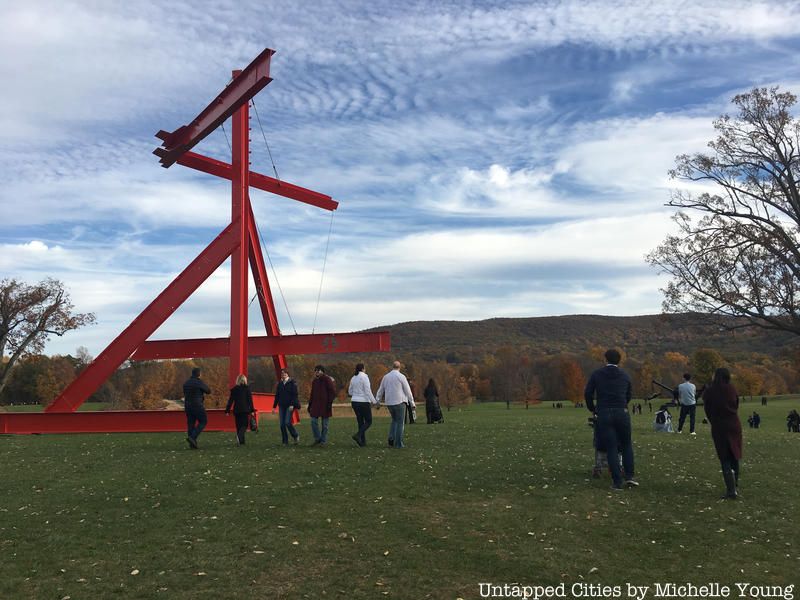NYC’s Forgotten ‘War on Christmas Trees’
Discover how an obscure holiday crackdown affects festive street vendors today!



Large Scale: Fabricating Sculpture in the 1960s and 1970s (Princeton Architectural Press), by Jonathan D. Lippincott, is a photographic documentary of the coming of age of large public sculpture. In 1966 the author’s father, Don Lippincott, and his business partner, Roxanne Everett, opened a studio in New Haven, Connecticut, specifically for large-scale projects. During the course of over 20 years, Everett captured on film all the artists that came through the Lippincott studio, documenting their work and creative process. Her prescience””to know the world would one day care about the day-to-day workings of the studio””is the essence of the book. While not a professional photographer, she received instruction on photography and the developing process by sculptor Clement Meadmore””an example of the true collaborative spirit that existed at the studio.

After WWII,architecture continued what the Bauhaus school had started and Modernism became a quest for the most “authentic expression of contemporary construction.” Ornamentation was eschewed for the honest expression of a building’s materials and engineering. Artist and architect parted ways and art was relegated to museums.
It was during this period that open public spaces””such as those in front of the Seagram Building or Lever House””were becoming more common, and in fact, built into zoning codes such as New York’s 1961 Zoning Resolution. It was thought that art would make these spaces more habitable and add to quality of life. And the art that seemed to best fit within these new sleek buildings was monumental modern sculpture.
Lippincott Inc. provided a mechanism that brought art back to architecture. This new art was large and daring. (Prior to this time, larger sculpture was primarily commemorative””for example, generals on horses.) It was what these new public spaces seemed to need. The flyer for Detroit’s 1969 Sculpture Downtown exhibit read “ Why make a SOMETHING which seemingly exists for no other purpose than itself alone? Because it fits the urban environment”¦”
In the 1960s, as artists struggled to find a voice and move art out of pretentious galleries and onto streets, the Lippincotts provided a nurturing workshop with open minds and a practical sense. In effect, large sculpture became a possibility””albeit a challenging one””and some of the greatest artists of our time took advantage of the situation.
The expressions captured on photographs of Claes Oldenburg and the workers at Lippincott puzzling over the production of Standing Mitt with Ball, or Oldenburg and Lippincott engineer Bob Jennings pondering drawings of Batcolumn, reflect their mystification and determination as they set out to accomplish something never done before.
The exceptional size of Robert Grosvenor’s Untitled and its installation at Storm King will take one’s breath away. The structure seems so simple today, but the enormity of the task in 1970 is captured in Everett’s wonderful black-and-white photographs.
One gets a sense of the camaraderie and fellowship among the many artists in a photo””including Roy Lichtenstein and his wife Dorothy Herzka””standing together laughing in front of two sculptures-in-process, Oldenburg’s Clothespin and Jean Dubuffet’s La Chiffonniere.
Menashe Kadishman summed up the situation at the Lippincott studio: “Everyone was so friendly and helpful. Also my English was not so good then, and when I was thinking of New Haven I translated it as ‘new heaven,’ and really I felt like I was in Paradise”¦The people at Lippincott were true partners in the final sculpture.”
There is a general public conception that artists are above the actual act of conducting business. Hardly true, as even Michelangelo complained of working too hard for too little money. Through the book you learn a little bit about how the Lippincott studio eased the artists through the business side of the art world.
Lippincott pioneered the concept of partnerships, and the author does a nice job of putting forth the financial arrangements the factory made with the artists. A discussion of the process of bringing art dealers, patrons and museum curators into the factory shows its impact on the public perception and acceptance of this new type of art. However, with the exception of an interview with Don Lippincott, explanation of the actual artistic process from conception to realization is not as detailed. The Lippincott studio always had approximately 16 employees. They were as vital to the process””bringing the craft of making art to the table””as the original artist’s sketches. While their contribution is inferred in the photographs, it is minimally explored in regards to many of the individual pieces.
The book contains a small chapter on the 1980s and ends with a full-spread color photograph of Alfred Lippincott (head of the company through the 80s and 90s) standing with Tony Smith’s immense sculpture Smug. It is an apt ending to the book: though never smug, the Lippincotts had every right to be.
This article is part of an on-going series of reviews on titles from Princeton Architectural Press. Purchase Large Scale: Fabricating Sculpture in the 1960s and 1970s on Amazon.
Get in touch with the author @PQPP3.
Subscribe to our newsletter